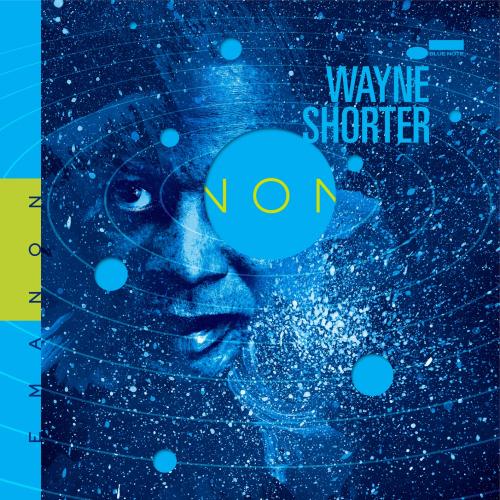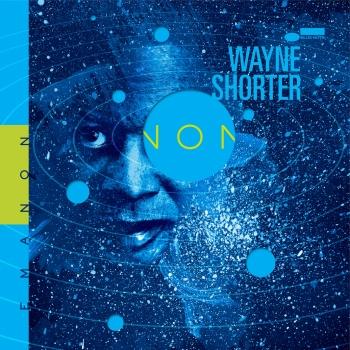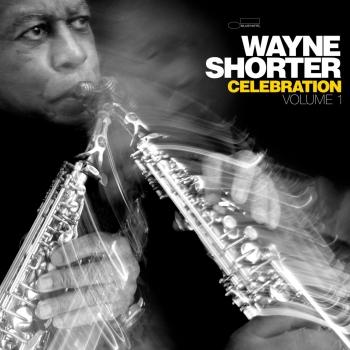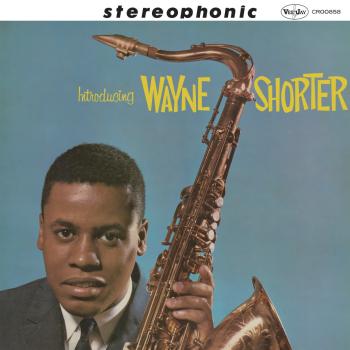
EMANON Wayne Shorter
Album info
Album-Release:
2018
HRA-Release:
18.01.2019
Album including Album cover
I`m sorry!
Dear HIGHRESAUDIO Visitor,
due to territorial constraints and also different releases dates in each country you currently can`t purchase this album. We are updating our release dates twice a week. So, please feel free to check from time-to-time, if the album is available for your country.
We suggest, that you bookmark the album and use our Short List function.
Thank you for your understanding and patience.
Yours sincerely, HIGHRESAUDIO
- 1 Pegasus 14:55
- 2 Prometheus Unbound 08:19
- 3 Lotus 15:17
- 4 The Three Marias 12:30
- 5 The Three Marias (Live) 27:31
- 6 Lost And Orbits Medley (Live) 09:51
- 7 Lotus (Live) 13:36
- 8 She Moves Through The Fair (Live) 06:24
- 9 Adventures Aboard the Golden Mean (Live) 04:31
- 10 Prometheus Unbound (Live) 14:26
Info for EMANON
Wayne Shorter was 15 when he first wrote and Illustrated his first comic book in blue ballpoint pen. That was in 1949, and Shorter has traveled great distances since, becoming an influential saxophonist, a 10-time Grammy winner and one of the most highly regarded composers in modern jazz. But as any fan of Shorter's can attest, he has held onto his teenage fixation with superheroes and sci-fi, as well as the comic book arts - so it's fitting that his highly anticipated next release, Emanon, released on Blue Note includes an original graphic novel — a cosmic-heroic odyssey written by Shorter with help from the screenwriter Monica Sly, and featuring art by Randy DuBurke — along with three albums of new music. With Emanon, Wayne Shorter shares his artistic multiverse. Everyone will create his or her own experience with the novel and music—but be prepared for that experience to involve the unknown.
"For decades, composer and saxophonist Wayne Shorter has led one of the more impressive quartets in jazz. With pianist Danilo Perez, bassist John Patitucci, and drummer Brian Blade, the 85-year-old saxophonist has explored the connections between chamber music and jazz. This band rehearses on-stage, creating innovative architectures via in-the-moment dialogue and improvising with unbridled freedom that never gives way to excess. Emanon is their first recording in five years and conceptual in nature. It comprises a four-part suite in a studio date from 2013 with the Orpheus Chamber Ensemble, and two 2016 live discs of the quartet playing the Emanon material with other tunes.
Disc one begins with piano and soprano sax probing the suggestion of melody, but really it's the pianist offering Shorter a chance for dialogic thought. Orchestral brass, strings, and the rhythm section enter minutes later and create melody from rhythm and vice-versa. The full orchestra's colorful voicings introduce "Prometheus Unbound" with a majestic grandeur balanced by the quartet's subtler interventions. "Lotus" commences as a full-on orchestral thematic statement answered by a recurrent three-note piano ostinato that's countered by free blowing from Perez and Shorter. They are barely held in check by the fluid pulse from Blade and Patitucci. The chamber group's bold yet lush restatement later in the piece frames the quartet's interrogatory investigation of blues. "The Three Marias," whose origins date back to 1985's Atlantis, is rendered completely anew with Bernstein-esque orchestral flourishes and a sweeping theme. Shorter plays soprano and tenor with equal vigor. The quartet emerges to take over with speculative and assertive conversation until the last third, where the orchestra returns with tempi, texture, and dynamic changes ushering in a sweeping conclusion.
The two live discs begin with a radically revisioned 27-minute version of "The Three Marias," where the group's close listening and instinctive risk-taking chart the unknown amid post-bop, modal jazz, and free improv. The medley of "Lost" and "Orbits" is edgier, traversing out jazz one moment and swinging grooves the next as Perez provides a wide palette for his bandmates to color. The final disc opens and closes with kaleidoscopic quartet versions of "Lotus" and "Prometheus Unbound," with stops at the traditional "She Moves Through the Fair" (unrecognizable from their 2003 version) and a short, blistering "Adventures Aboard the Golden Mean" that goes from 0-60 instantly in a bluesy workout led by Shorter's soprano, followed by Perez's Latin montunos and vamps given a heavy bottom by the rhythm section. While Emanon's suite may take some getting used to, it is a profoundly imaginative work; the quartet concert offers a killer portrait a group whose M.O. is pushing at the margins until they give way to something altogether new." (Thom Jurek, AMG)
Wayne Shorter, tenor saxophone, soprano saxophone
John Patitucci, bass
Brian Blade, drums
Danilo Perez, piano
Orpheus Chamber Orchestra
Clark Rundell, conductor
Recorded 2013-2016 at The Barbican, London; Avatar Studios, NYC; Danilo's Jazz Club; American Trade Hotel; Casco Viejo, Panama
Produced by Wayne Shorter, Don Was
Wayne Shorter
Though some will argue about whether Wayne Shorter's primary impact on jazz has been as a composer or as a saxophonist, hardly anyone will dispute his overall importance as one of jazz's leading figures over a long span of time. Though indebted to a great extent to John Coltrane, with whom he practiced in the mid-'50s while still an undergraduate, Shorter eventually developed his own more succinct manner on tenor sax, retaining the tough tone quality and intensity and, in later years, adding an element of funk. On soprano, Shorter is almost another player entirely, his lovely tone shining like a light beam, his sensibilities attuned more to lyrical thoughts, his choice of notes becoming more spare as his career unfolded. Shorter's influence as a player, stemming mainly from his achievements in the 1960s and '70s, has been tremendous upon the neo-bop brigade who emerged in the early '80s, most notably Branford Marsalis. As a composer, he is best known for carefully conceived, complex, long-limbed, endlessly winding tunes, many of which have become jazz standards yet have spawned few imitators.
Shorter started on the clarinet at 16 but switched to tenor sax before entering New York University in 1952. After graduating with a BME in 1956, he played with Horace Silver for a short time until he was drafted into the Army for two years. Once out of the service, he joined Maynard Ferguson's band, meeting Ferguson's pianist Joe Zawinul in the process. The following year (1959), Shorter joined Art Blakey's Jazz Messengers, where he remained until 1963, eventually becoming the band's music director. During the Blakey period, Shorter also made his debut on records as a leader, cutting several albums for Chicago's Vee-Jay label. After a few prior attempts to hire him away from Blakey, Miles Davis finally convinced Shorter to join his Quintet in September 1964, thus completing the lineup of a group whose biggest impact would leap-frog a generation into the '80s.
Staying with Miles until 1970, Shorter became at times the band's most prolific composer, contributing tunes like 'E.S.P.,' 'Pinocchio,' 'Nefertiti,' 'Sanctuary,' 'Footprints,' 'Fall' and the signature description of Miles, 'Prince of Darkness.' While playing through Miles' transition from loose post-bop acoustic jazz into electronic jazz-rock, Shorter also took up the soprano in late 1968, an instrument which turned out to be more suited to riding above the new electronic timbres than the tenor. As a prolific solo artist for Blue Note during this period, Shorter expanded his palette from hard bop almost into the atonal avant-garde, with fascinating excursions into jazz/rock territory toward the turn of the decade.
In November 1970, Shorter teamed up with old cohort Joe Zawinul and Miroslav Vitous to form Weather Report, where after a fierce start, Shorter's playing grew mellower, pithier, more consciously melodic, and gradually more subservient to Zawinul's concepts. By now, he was playing mostly on soprano, though the tenor would re-emerge more toward the end of WR's run. Shorter's solo ambitions were mostly on hold during the WR days, resulting in but one atypical solo album, Native Dancer, an attractive side trip into Brazilian-American tropicalismo in tandem with Milton Nascimento. Shorter also revisited the past in the late '70s by touring with Freddie Hubbard and ex-Miles sidemen Herbie Hancock, Ron Carter, and Tony Williams as V.S.O.P.
Shorter finally left Weather Report in 1985, but promptly went into a creative slump. Still committed to electronics and fusion, his recorded compositions from this point became more predictable and labored, saddled with leaden rhythm sections and overly complicated arrangements. After three routine Columbia albums during 1986-1988, and a tour with Santana, he lapsed into silence, finally emerging in 1992 with Wallace Roney and the V.S.O.P. rhythm section in the 'A Tribute to Miles' band. In 1994, now on Verve, Shorter released High Life, a somewhat more engaging collaboration with keyboardist Rachel Z.
In concert, he has fielded an erratic series of bands, which could be incoherent one year (1995), and lean and fit the next (1996). He guested on the Rolling Stones' Bridges to Babylon in 1997, and on Herbie Hancock's Gershwin's World in 1998. In 2001, he was back with Hancock for Future 2 Future and on Marcus Miller's M². Footprints Live! was released in 2002 under his own name, followed by Alegría in 2003 and Beyond the Sound Barrier in 2005. Given his long track record, Shorter's every record and appearance are still eagerly awaited by fans in the hope that he will thrill them again. Blue Note Records released Blue Note's Great Sessions: Wayne Shorter in 2006. (Richard S. Ginell). Source: Blue Note Records.
This album contains no booklet.











